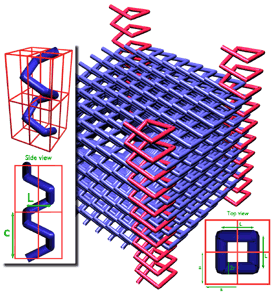Two scientists look to fabricate a magic crystal that can trap light
May 22, 2001

An artificial crystal composed of microscopic spirals could be a breakthrough that leads to sleeker, smarter, and sexier optical components, according to scientists at the University of Toronto.
Physics professor Sajeev John and his graduate student Ovidiu Toader (sic) designed the spiral structure to have an unusual optical property, called a three-dimensional (3D) "photonic bandgap." Their results were published in a recent issue of Science (11 May).
The meaning of all this is not readily apparent without delving into the murky depths of some difficult physics. But the bottom line is this: No light is allowed inside a photonic bandgap. If it were possible to engineer this property, then optical engineers would have a neat way of keeping light in its place.
Right now, optical engineers can trap light by strapping different materials together to create reflection at the boundary. Photonic bandgaps are different because they offer a way to control the optical properties of the material by changing its shape rather than its composition.
There's a consensus in the scientific community that photonic bandgaps will, one day, result in some pretty lucrative commercial inventions. But it's very early days and, in some senses, it's still a technology looking for a problem to solve. It's worth pointing out that not all photonic bandgaps are the same. Scientists want to design a structure where the photonic bandgaps -- bands of forbidden wavelengths -- overlap in all directions. Such a structure is termed a 3D photonic crystal.
It's worth pointing out that not all photonic bandgaps are the same. Scientists want to design a structure where the photonic bandgaps -- bands of forbidden wavelengths -- overlap in all directions. Such a structure is termed a 3D photonic crystal.
There's another group of structures called two-dimensional (2D) photonic crystals -- ones that are patterned in two directions but invariant in the third. These are simpler to make, and have potential uses in integrated optics (see The Hole Thing), and optical fibers (see A Fiber Filled With Air and BlazePhotonics Secures $9M Round).
However, to make active components based on photonic bandgap ideas, control of light in all three directions in space is important, says Toader. When light is generated in a semiconductor, it could spew out in any direction. So if the crystal only has a 2D photonic bandgap, light still can escape into the third direction.
John and Toader's is not the first design for a 3D photonic crystal, but the scientists say it should be a lot easier to fabricate than anything else that's been proposed. Fabrication is a big problem because of the scales required. To make a photonic bandgap that affects telecommunication wavelengths, the spirals in the crystal are on the order of a few microns across. The structure in the diagram (above) could fit on the head of a pin many times over.
"In terms of making a material that's three-dimensional with a large photonic bandgap, there's been a bottleneck in the field over the past 10 years," says John. "Other types of designs or blueprints for large photonic bandgaps were proposed, but their production is so complex or time consuming that for all intents and purposes they are commercially unusable. Our blueprint can be mass-produced at a very low cost, and that's the crux of the matter."
Previous 3D photonic crystals were made by drilling out microscopic holes to make highly complex structures. The spiral crystal is simple in comparison. It could be made using a technique called glancing angle deposition (GLAD). In this process, ions are fired at a substrate at a glancing angle, and spirals start growing at bumps on its surface. A computer controls the angle of the substrate, which can be tilted to control the direction that the spirals grow.
A team at the University of Alberta is working with this technique and has already made similar structures, says Toader. ( See http://www.ee.ualberta.ca/~brett/img/collage4.jpg)
Light Reading has also learned that John recently founded a startup called Keralight Inc. (no Website) that intends to exploit the properties of photonic crystals for telecom applications.
— Pauline Rigby, Senior Editor, Light Reading, http://www.lightreading.com
You May Also Like








